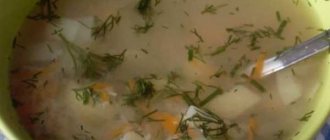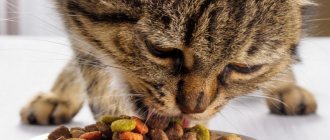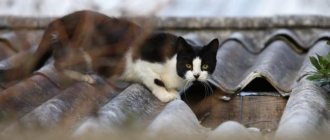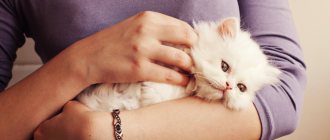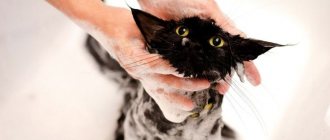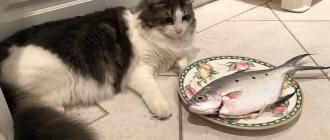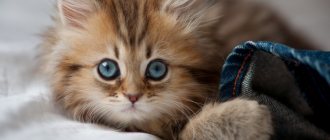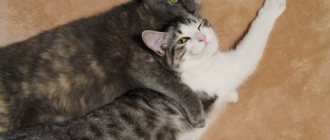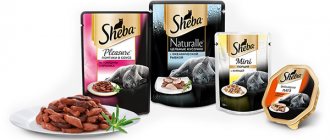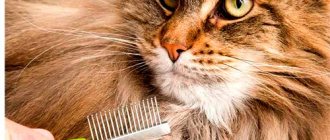The question of whether cats can be given fish - both raw and boiled - many owners of mustachioed and tailed cats do not ask themselves: they simply pamper their pets with mackerel, blue whiting, sprat, even herring, if at the very sight of it the pet begins to meow heart-rendingly, demanding to share . However, we should not forget that most allergic reactions, which are so difficult to get rid of, are caused by natural food in one form or another. In this article we will try to figure out: is it possible to give an animal an endless Thursday or not?
photo from website: pinterest.com
Is it possible to feed a neutered cat fish?
There is an assumption that after castration, the likelihood of developing urolithiasis may increase. Therefore, most veterinarians, after surgical intervention, advise owners to completely exclude fish products from the menu of a castrated cat in order to prevent the development of serious pathology.
Still, many experts believe that it is permissible to eat fish, but very infrequently, once every 14 days, boiled and in small quantities. However, it is worth observing the following requirements: low-calorie products, always boiled and not raw meat, and also the absence of extra pounds. at the pet's.
Pixabay.com
Why are fish dishes contraindicated for neutered pets?
In castrated animals, which, unlike sterilized ones, have lost their ovaries or testes, the hormonal system and metabolism change. After the procedure to deprive them of reproductive function, they automatically fall into the risk group for kidney and endocrine diseases. The components found in fish negatively affect the functioning of the relevant organs, so eating fish by cats after castration is not recommended.
The absorption of elements contained in these products is inhibited, and a tendency to accumulate them develops. Accumulating in the body of castrated animals, they lead to the appearance of stones in the organs of the urinary system. Despite the enormous health benefits for cats, fish dishes should be offered to them extremely rarely.
Castration imposes additional restrictions on the nutrition of representatives of this family, especially on those foods that can provoke the formation of stones in the organs of the urinary system. This point should be taken into account when deciding to get a kitten and accustoming it to natural food.
Many people treat pollock with disdain. They believe that this cheap fish is only suitable for feeding animals. There is also an opinion that the packaging under a layer of ice contains a product that is not the freshest. Roskachestvo experts studied the properties of fifteen brands of pollock. We will present their conclusions and also tell you how true the myths about this fish are.
Is it possible to feed a sterilized cat fish?
Why can't cats eat fish? Sterilization implies many restrictions on the cat’s diet, and especially on fish products. The absorption of elements slows down, and there is a tendency to become overweight. Because of this, veterinarians recommend excluding fish from the menu of a sterilized pet.
For such cats, it is possible to prepare porridge, purees, and soups in fish broth. It is allowed to supplement the menu with vegetables and herbs.
Pixabay.com
How to keep your cat safe?
Pets are not allowed smoked, dried, fried, dried, salted fish, canned fish, heads, bones. When smoking, helminths are not destroyed. Salt, preservatives, carcinogens, allergens, excess fat provoke problems with the kidneys, pancreas, liver, and metabolic processes. Temperature treatment reduces the risk of helminth infection, since the parasites die within 20 minutes, and trimethylamine oxide and thiaminase are destroyed during cooking in half an hour. In frozen fish, the chemical composition does not change, but low temperatures from -18° C also destroy parasites within 4 days. Before feeding, it is recommended to scald defrosted fish with boiling water.
There are varieties of fish that are not recommended for a cat's diet. These include carp, which is more often than other species a carrier of helminths. Blue whiting is not a good choice for cats as it contains iodine and minerals in abundance. Sprat is a very small fish from which it is difficult to remove bones. It is better to exclude herring and capelin from the menu due to the increased level of trimethylamine oxide, and herring, sardinella, bream and perch - due to the high concentration of thiaminase. Cats should not eat fish that have been stored improperly, such as mackerel and mackerel, which release toxic histamine.
What kind of fish can you give your cat?
A large number of breeders are interested in the question: is it possible to feed a cat fish and how much to give? Your pet should eat fish once every 7 days. However, these must be different varieties. When selecting products for a cat’s diet, you need to take into account the age and well-being of the animal, and what it eats best. Pets are allowed to feed sea and river fish, although the choice falls on one option.
Names of fish that are best to feed cats:
- pollock;
- hake;
- cod;
- salmon;
- trout.
When selecting, it is necessary to take into account the type of product on the pet’s menu, such an indicator as the animal’s obesity. If he is rapidly gaining extra pounds, then it is unacceptable to give him fatty fish options, such as sardines, mackerel, and herring. For large pets, low-fat varieties are better - hake, pollock or cod. These dietary seafood are low in fat, but also low in vitamins A and D.
If a cat expecting offspring eats a white product, then this can become the basis for a deficiency of vitamins in the body. It is advisable to give pregnant fluffies less often, about once every 14 days, red fish, due to the higher content of nutritional omega acids and vitamin components. Many owners completely exclude all types of seafood from the cat menu if they are planning to become mothers, believing that these products are harmful during the period of gestation of kittens.
Raw or cooked
Nothing will happen to your cat from eating a piece of fish once a week, so a reasonable solution is to alternate raw and cooked fish and not overfeed. Before entering shopping centers, it undergoes veterinary control and is frozen at minus 40 ℃. Danger lurks in fresh fish, which has just been caught from the river or bought secondhand. This product cannot be given.
The cat will not develop health problems if you do not take fish as the basis of its diet, choose healthy species for it, pre-disinfect it and cook it.
Benefits and harms
So, is it still possible to pamper your pet with treats made from red and white fish, or is there no point in taking such risks? To understand this issue, you need to familiarize yourself with the beneficial and harmful properties of such a product.
Among the main beneficial qualities of fish are:
- contains easily digestible protein in the structure;
- high% of vitamins A and B;
- there is a large amount of phosphorus and magnesium in the structure;
- fatty fish can act as a source of Omega-3 acid.
However, fish has many more harmful properties:
- Causing damage to the kidneys. The high percentage of salt contained in the structure of the product negatively affects the functioning of this organ. Often, pets who are given fish suffer from urolithiasis, since the presence of phosphorus and magnesium in the structure contributes to the appearance of urinary stones.
- Increased risk of developing helminthiasis. Against this background, damage occurs to the liver, gallbladder and pancreas. Often, helminthic infestation is provoked by an incorrect cat menu. It is unacceptable to feed a purring pet raw fish that was caught in the river.
- The development of hypovitaminosis, which appears against the background of the presence in the structure of many types of product, the enzyme thiaminase, which destroys B vitamins. Subsequently, the animal begins to suffer from anemia.
- A decrease in the content of vitamin E in the body, which occurs against the background of regular addition of this product to the cat’s menu.
- A significant number of bones, which is often used as a motive to injure the throat and stomach area of the pet.
Why can't these animals fish? One of the reasons is the content of destructive thiaminase in the structure of many varieties of fish. It promotes the destruction of vitamin B. To destroy the dangerous substance, you need to cook the fish for at least 10 minutes.
Pixabay.com
Types of fish and beneficial properties
Depending on the habitat of the fish, its types are distinguished - oceanic (tuna), sea (cod, halibut and others), freshwater - lake, river, migratory - which lives in the sea, but spawns in rivers (sturgeon class). Fish that live in salty sea or ocean water are noticeably different from lake and river fish.
It contains many trace elements and mineral components, but the composition depends on the variety. Sea fish is usually divided into lean, white, and fatty. The first class includes hake, cod, haddock, flounder and some others. This fish is rich in proteins, microelements, minerals, and has little fat. Fatty fish include mackerel, salmon, herring, capelin, and sprat. It should not be given to domestic cats that are prone to obesity.
Dry cat food
If a novice breeder does not have enough time or knowledge to keep a pet on a natural diet, you can feed it with ready-made food. Their use greatly simplifies the procedure of feeding a pet; however, there are rules that must be followed so as not to harm the cat’s well-being.
It is strictly not recommended to give animals cheap food that is sold in every grocery store. They are made from low-quality ingredients and contain dyes and flavoring additives that are detrimental to the animal’s well-being (prolonged consumption of such feeds provokes the development of urolithiasis). Also, additives in cheap food provoke addiction, and in the future it will be difficult to switch your furry friend to normal nutritious food.
You need to purchase professional food. Their price is significantly higher, but it is completely justified. This food has a balanced structure, is made from high-quality products (usually meat and cereals), and has no dyes or flavoring additives. A large assortment of products makes it possible to choose food depending on the age category, what they like best, breed, and state of health of the animal.
Pixabay.com
Wet food and canned food
These foods are excellent for kittens and older cats.
An alternative to dry food is moistened food and canned food. They contain all the elements required for pets and have a balanced structure, are also easier to chew and are suitable for kittens, older cats and pets with a sensitive digestive system. Canned food is produced in single-use packages and cans, their humidity reaches 85%, so cats drink less water when fed wet food.
The disadvantages of wet food include a shorter shelf life than dry food and the need to store open packaging in the refrigerator. When purchasing such food, you should carefully inspect the packaging - it should not have any swelling, damage, or traces of rust; the expiration date of the food should also be checked.
Freepik.com
Herring
By feeding your cat herring, you supply his body with an enzyme, trimethylamine oxide, which destroys vitamin B1, which is necessary for the normal functioning of all metabolic processes in it. This enzyme is concentrated mainly in the heads of the herring, as well as in the insides - these are the parts that the pet often gets when cutting the fish.
By the way, due to the hormone contained in herring, cats often experience anemia - their body begins to poorly absorb iron.
How to do housework correctly: the guy “challenged the carpet to a duel” (video)
Just extend your hand. Savvy shoppers take the 'far away' bottle of oil
Painted church walls with portraits of his beloved: the secrets of the artist Mikhail Vrubel
Don’t forget that canned herring, which people often feed to their cats, has a laxative effect on the pet’s digestive system.
Is it possible to give a cat smoked, salted fish or river fish with bones?
Experts strongly recommend against feeding your pets smoked and salted products. Smoked meat is quite difficult for a furry pet and has a negative effect on the liver. Subsequently, the manufacture of such a product creates carcinogens that negatively affect the gastrointestinal tract and provoke the development of tumors. Salted fish contains a large amount of salt, which is contraindicated for pets. Excess salt may cause cramps, diarrhea, excessive urination, lethargy and increased thirst. The animal can die within 24 hours.
Fish with bones from fresh water should not be fed to pets. The bones themselves become the cause of most diseases and visits to the veterinarian:
- the bones can harm the throat when the animal begins to chew fish fillets;
- sharpened fragments can scratch the stomach when passing through it and are a cause of injury and bleeding;
- In the gastrointestinal tract of a cat, pointed bones provoke an inflammatory process or sepsis.
It is possible to remove a fish bone from a pet's body only under general anesthesia, however, an x-ray will need to be taken in advance.
Before feeding your pet fish, be sure to cut off the fins and gills. They can damage the pet’s internal organs - injure the walls, and thus cause bleeding and digestive disorders.
Pixabay.com
What is the danger of fish
Under natural conditions, cats do not eat fish because they cannot catch them. Scientists have proven that the ancestors of the domestic purr were the African wild cat. She does not hunt fish, only birds and small rodents. In addition, cats naturally suffer from hydrophobia. A man taught them to eat fish. Firstly, because fish is cheaper than meat, and secondly, because many amateur fishermen willingly share their “catch” with their pets.
However, experts do not consider fish and other seafood to be healthy food for domestic cats. It contains too much protein and minerals, which over time can provoke urolithiasis - urolithiasis. The “building materials” for struvite formed in the bladder are magnesium and phosphorus. Frequent feeding of fish can lead to vitamin deficiency - a deficiency of vitamin K. It plays an important role in proper blood clotting. The body of pets synthesizes this vitamin from many foods, but the “fish menu” does not support this synthesis.
The enzyme thiaminase, which is found in fish, destroys vitamin B1, and trimethylamine oxide binds iron, which leads to anemia in the pet. Cats cannot absorb the amount of iodine that sea fish contains, which can result in hyperthyroidism, a disease of the thyroid gland.
River fish contains a lot of bones that can damage a cat's esophagus and intestinal walls, causing life-threatening internal bleeding. The danger of helminthiasis should not be ruled out, so under no circumstances should fish caught in a river or lake be given raw.
Fish protein is one of the most powerful allergens, and in the reservoirs where it lives, you can find the entire periodic table; as a result, many types of fish contain salts of heavy metals (including mercury and other dangerous compounds) and other toxins. Even fish grown in artificial reservoirs can pose a danger to pets - antibiotics and chemical additives are often used in incubators.
How to stop a cat from eating fish
It is necessary to replace fish protein with meat protein. But what should cat breeders do, who, due to their inexperience, always gave them fish, and now they refuse other food? Could this mean that there is no need to change anything, and let this product remain in the diet? Definitely not. It is necessary to wean the animal off it, but this should not be done immediately, so as not to cause mental trauma to the purring pussy. It is necessary to understand that it is very difficult to overcome an addiction to fish, but by correctly replacing fish protein with meat protein, you can quickly achieve results, and you will not need to endanger the well-being of your furry friend.
By the way, by choosing boiled fish on your pet’s menu, if he really loves this seafood, you can give him ready-made fish-flavored food. It turns out that for ready-made complementary foods, the products undergo special processing cycles, and for taste and aroma they are supplemented with completely safe fish meal, in optimal quantities. And, Omega-3 and Omega-6 fatty acids from the fish structure can be easily replaced with additional vitamin components and supplements.
Taking into account all these suggestions, you can ensure that the fish on your pet’s menu will be a treat for him to enjoy, and not food that could threaten his life and health.
Did you like the recipe?
TOP list of the most useful and wallet-friendly fish
Fish is one of the most delicious and healthy foods in the diet. Even for those who don’t particularly like the inhabitants of water on their table, you can always choose an option.
As a rule, people who say this consider only salmon or sturgeon to be fish.
But in fact, there are enough types of fish that will not burden the budget and will become a real feast of taste and health.
General information
Naturally carnivorous cats need a lot of protein. Cats also need carbohydrates, in very small quantities. With natural feeding, 80% of the food in the diet should serve as sources of protein.
The basis of a cat's diet should be meat - beef, veal, poultry, rabbit. Eating pork is acceptable if the meat is lean and well cooked. It is better to freeze the meat and serve it raw; this method is more natural. An adult cat with healthy teeth is fed meat in pieces. There is no need to cook mince because the teeth remain healthy while the cat needs to chew its food.
Milk and dairy products must be present in a cat's diet. Preference is given to cottage cheese, yogurt, homemade yogurt and natural cheese. Whole milk can cause diarrhea, which indicates lactose intolerance. Store-bought dairy products are made from a powder mixture, so their benefits are questionable.
We invite you to familiarize yourself with: Black German Shepherd
Chicken and quail eggs are a source of protein, fats and vitamins. The only disadvantage of the product is the risk of allergies and high calorie content. Eggs should be present in a cat's diet no more than 1-2 times a week. Quail eggs can be given more often. As for preparation, it all depends on the cat’s preference; some purrs like boiled eggs, and some like raw ones. Alternatively, you can make an omelet from one egg and milk (without butter).
Vegetables, fruits and grass are a source of vitamins and coarse fiber. Your cat must be fed coarse fiber otherwise its digestive system will not work properly. Cats rarely eat vegetables in their pure form, so they are chopped and mixed with cottage cheese or meat. Vegetables can be given raw or cooked.
Cereals are a source of carbohydrates. As mentioned above, a cat does not need large amounts of carbohydrates, so porridge does not need to be given more than 2 times a week. Rice and buckwheat are good for feeding cats; you need to be careful with other cereals.
Fillet is subjected to repeated freezing and thawing
Pollock meat is lean. If the fillet is re-frozen, it becomes excessively dry and tough. Experts have determined the percentage of deep dehydration of fish. This indicator indicates whether the fillet has been refrozen.
In thirteen pollock varieties, deep dehydration did not exceed 10% of the total mass. This indicator is the norm. This means that they were not defrosted during transportation. Only in two brands (Fine Life and Flipper) did deep dehydration exceed the norm several times.
Dry pollock meat
To determine the juiciness of a fish, you need to determine its water-holding capacity. This indicator is very important. It indicates the process of protein denaturation and the quality of muscle tissue. The fresher the fish and the less the fillet has been exposed to temperature fluctuations, the higher this indicator.
According to the quality requirements for fish products, the water-holding capacity must be at least 50%. Experts have found that the following brands of pollock meet these standards:
These varieties of fish can be considered the most juicy.
